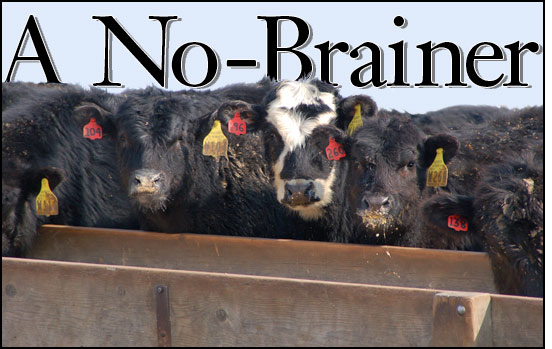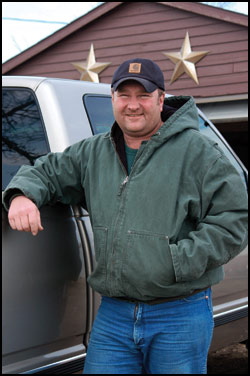For Nebraska's Curtis Koehn, AngusSource® and Gateway program participation is

If Curtis Koehn's teenage son follows tradition, he will be the fifth generation to farm the home place, near Stanton, Neb. It will be up to the youngster to decide what he will do, of course. If it is farming, though, Koehn would encourage his son to consider diversifying his agricultural interests. That, too, is sort of a family tradition.
Koehn and his wife, Denise, have sought their own brand of diversity through crops and cattle. It has worked, too, allowing their operation to grow. Not that it's become a big, fancy showplace boasting high-volume production. It's still modest in size and scale, but production has grown incrementally through the years. Most importantly, the Koehn operation has grown more profitable.

"Cattle have been good to us," Curtis Koehn says, "And even though we aren't large producers, we've tried to be efficient and look for ways to add value to the cattle."
"Cattle have been good to us," Koehn states, with his characteristic grin. "And even though we aren't large producers, we've tried to be efficient and look for ways to add value to the cattle. That's why we used AngusSource® and now Gateway to verify our cattle for source and age."
Progression to Angus
Like his son, Koehn became interested in agriculture at an early age. He started farming this family place on shares while it still belonged to his grandmother. He bought his first brood cows in 1980. To build his herd and replace culls, Koehn purchased Angus-Hereford crossbred heifers. Early on, he used Continental bulls, turning to registered Angus bulls about 20 years ago.
"Before that, I'd take 40 calves to the sale barn and they might sort them 20 ways," Koehn jokes. "They really did lack uniformity. Switching to Angus bulls gave us calving ease, more vigorous calves and more uniformity. We improved even faster after I learned to use EPDs (expected progeny differences) to select for balanced traits."
Koehn's farming enterprises have been adapted to this part of northeastern Nebraska's hilly terrain, erodible soil and lack of irrigation. Dryland corn is a traditional crop, but it's now cultivated under minimum tillage practices. Alfalfa is grown in rotation with corn. Alfalfa hay is primarily a cash crop, since other forages provide hay and supplemental grazing for Koehn's cattle.
"We raise forage oats for hay, and sometimes a second crop is sown on the same ground to graze in the fall. We've planted other annuals, too, for hay or grazing. We've even grazed turnips. We can usually raise quite a bit of forage, so having a cow herd has always made sense to me," Koehn says. "With the pasture we have, and the supplemental forage and our cornstalks, we can run about 150 cows."
Feedlot offers insight
Having the grain and forage resources necessary to finish cattle looked sensible, too, so Koehn started feeding his own calves and, occasionally, some additional purchased calves. Koehn's feedlot is a fairly low-input facility, utilizing electric fence, wooden feedbunks and a bare minimum of equipment. Koehn could get out of the cattle-feeding business easy enough, considering his low investment in infrastructure.
 He has no plans to quit, especially since he's becoming a more savvy feeder.
He has no plans to quit, especially since he's becoming a more savvy feeder.
Feeding the cattle gives Koehn firsthand knowledge that's useful in tweaking his breeding program. Sold directly to a beef packer, the cattle are priced according to a grid that takes carcass merit into account. Early in his feeding career, Koehn was particularly dissatisfied with how his cattle graded. Consequently, he adjusted his sights for genetic selection, placed more emphasis on carcass EPDs and realized measurable improvement.
"It's a lofty goal, but I'd like for every calf to reach a finished weight between 1,200 and 1,400 pounds (lb.), with all grading Choice or better. Ideally, all would qualify for Certified Angus Beef® (CAB®), with no 'outs'," Koehn says.
"That's what we shoot for. In reality, they have been grading 87% to 93% Choice, with around 30% going CAB. And we still end up with a few yield grade (YG) 4s. We're working hard to take care of that, and I think we can. We've been getting group carcass data back, but we're going after the individual data. That will help."
Using AngusSource since 2005
Koehn has been a participant in the AngusSource Process Verification Program (PVP) since 2005. Cattle enrolled in the program are identified with the official AngusSource eartag and verification certificate. Their verification remains intact throughout the animal's lifetime and through all marketing and production channels. Koehn says the requirements were relatively simple: They must be sired by a registered Angus bull. Calves must be enrolled by the ranch of origin and, at a minimum, must have a record verifying the birth date of the oldest calf within the enrollment group.
"I was already keeping records on the calves, or my wife was," Koehn says, smiling. "About the only extra things we needed to do were to sign up and put in the tags. Through the program, the calves gained added value by being age- and source-verified. It was a no-brainer."
As a seller of finished cattle, Koehn also sought approval under the AngusSource Feedyard Umbrella, and has claimed premiums packers pay for age-verified cattle in addition to any other grid or branded-beef program premiums.
"Packers will pay more for cattle with a documented history," Koehn states. "We've received premiums of as much as $35 per head. Why wouldn't you sign up for this kind of program?"
It has also been helpful in getting back carcass data, Koehn says. "So far, we've got back group information only, but we're going after individual data."
Gateway extension
In recent years, Koehn has been retaining home-raised heifers as herd replacements. Because he still favors an Angus-Hereford crossbred cow, chosen Angus females have been mated with a Hereford bull to sire F1 heifers. A drawback is that any of the Hereford-sired heifers going to the feedlot, instead of the breeding pasture, and their steer mates are not eligible for AngusSource.
However, a companion program fills the bill for Koehn's Hereford-sired calves. According to AngusSource Director Sara Snider, a second tier of the AngusSource PVP, called Gateway, verifies source and group age only, but has no genetic requirements.
"I was excited to be able to call Curtis and tell him about the launch of Gateway and to explain that not only could he enroll them in our ranch program, but he could continue his participation in our feedyard program. Both AngusSource and Gateway calves are eligible for coverage in the feedyard umbrella," Snider says.
"The Gateway verification option was developed with producers like Curtis in mind," she adds. "It's for producers who have worked with AngusSource who, for one reason or another, could no longer meet the genetic requirements but still had home-raised calves they would like to source- and age-verify. Prior to Gateway we had to recommend another program to these producers and hope that someday we would be able to work with them again if their calves qualified for AngusSource. Now, with Gateway, they are able to continue their working relationship with us year after year. They are able to follow the same record requirements and enrollment protocol, and they receive the same customer service and marketing support."
Koehn says it didn't take much of a pitch to sell him on Gateway. He credits the AngusSource staff for making it easy to participate, all the way from his first-time enrollment in AngusSource, through successive years, to the recent adoption of Gateway.
"My experience with AngusSource," Koehn states, "made choosing Gateway another no-brainer."
[Click here to go to the top of the page.]







